Korgen lyfter- Raising Basket Knowledge.
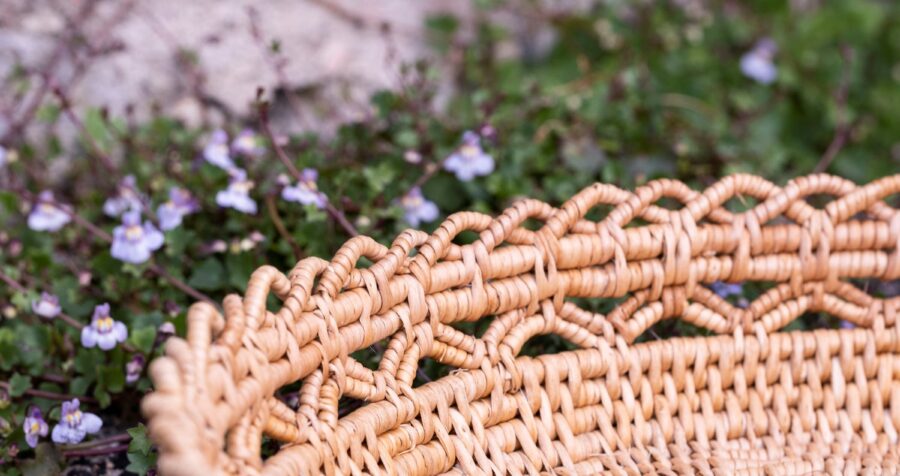
Background
Main photo: Detail from a coiled birch root basket in the exhibition Beloved Baskets. Photo: Linnea Rundgren.
Basket making is one of the world’s oldest crafts, and baskets were one of the first means of transport, collection and storage. Basketmaking is global: Technically there are many similarities between baskets made in different places of the world. Even though the materials have varied, most have been made using local and natural materials.
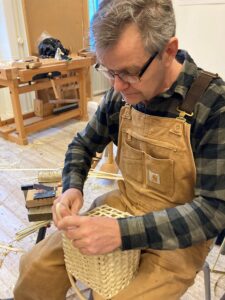
Weaving hazel. The technique has mainly been common in the south east of the country. This type was representative both on the first and second five weeks courses. Photo: Helena Åberg.
Baskets have many notable benefits for the climate, especially when they are made locally from indigenous natural materials. Baskets are durable, can be used for a long time, unlike plastic and paper bags. When worn out, they can return to the eco-cycle. In Sweden, the tradition of basket making is very varied due to the country’s many climate zones providing a wide variety of materials. Baskets have had a great importance in society, not least during the early stages of industrialism.
In the beginning of the 20th century there were around 1800 basket makers in the country. During our inventories in this project, we have concluded that there are as few as approximately 80 professional or semiprofessional basket makers left, many of whom have reached retirement age. Most often, there each technique has a few makers left and some have none at all. This means that many techniques connected to materials and basket types are worthy of safeguarding based on the UNESCO Convention of the Safeguarding of the Intangible Cultural Heritage.
Therefore, the multiyear national project Korgen lyfter (Raising Basket Knowledge) was initiated in 2019. The project is led by the Handicraft Association of Scania (Skånes Hemslöjdsförbund) in collaboration with the regional Sörmlands Museum. At the beginning, the Handicraft Association of Östergötland (Östergötlands läns hemslöjdsförening) was also included. The project is financed by the Swedish National Heritage Board (Riksantikvarieämbetet) and the National Swedish Handicraft Council (Nämnden för hemslöjdsfrågor).
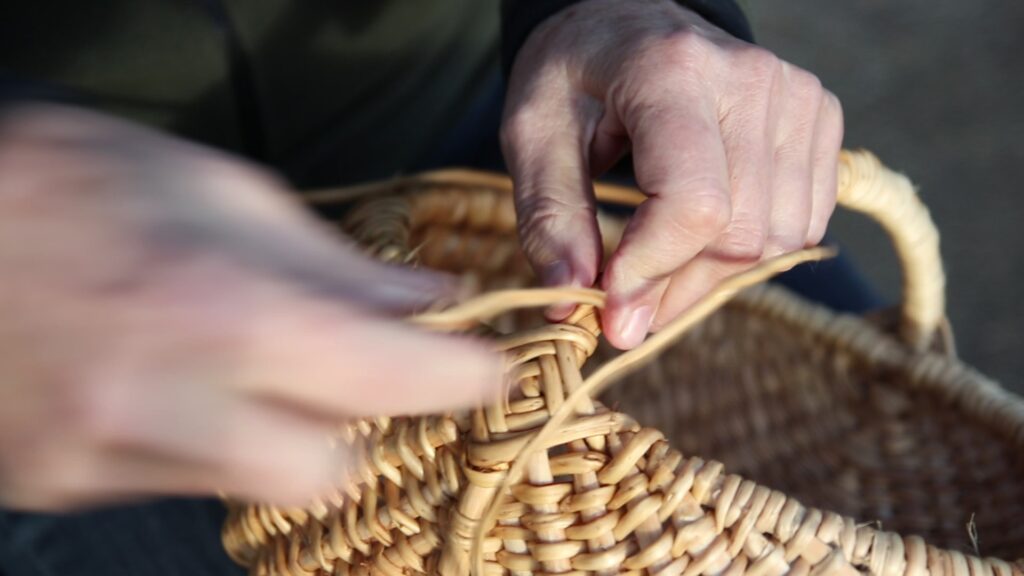
Rib basket with spruce roots and spruce branches have been common especially in the middle of Sweden. This type was representative both on the first and second five weeks courses. Photo: Amanda Görander Frost.
Why safeguard?
There are several reasons to safeguard traditional basket making where indigenous materials are used.
- Basket making has a fragile position, partly because it has had a low status in society. The basket is an everyday object that has only in exceptional cases been seen as a status symbol.
- In basket making, there is a great deal of intangible knowledge about gathering and processing materials, as well as weaving or coiling the baskets.
- Although some processing of basket materials nowadays can be done by machines, more or less all baskets are still made by hand. This means that baskets have been made in the same way for tens of thousands of years.
- There is no formal basket training in Sweden, which is a threat to the survival of basket making. What exists is an apprenticeship, which in itself is good, but unfortunately there is a lack of mentors.
- It is difficult for domestic basket makers to compete with baskets from low-cost countries.
- Due to climate change and modern forestry and agriculture, certain materials have become increasingly difficult to find.
Objectives
Korgen lyfter aims to
- Strengthen and support the diversity of basket tradition that we can find in Sweden.
- Increase and spread the knowledge and interest in basket making.
- Support already active basket makers and widen the possibilities for professional basket makers.
- Highlight basket making as an important intangible cultural heritage through education and documentation.
- The project’s ambition is that it should include craftsmen as well as people interested in baskets throughout the country and that it can inspire other similar projects.
How it was done
Korgen lyfter has worked in-depth through, for example, educational efforts, inventorying, seminars and lectures. In parallel, we have worked with public education through a high digital presence as well as an exhibition and activities in various locations. This provides both depth and breadth as well as a good geographical spread. The project operates throughout the country, which is promoted by the interregional cooperation with shared project leadership in two different regions. The implementation of the project began with an evaluation of the situation in the country.

Newly made baskets with traditional basket techniques shown in the exhibition Beloved Basket!. The baskets are a good example of diversity in materials and techniques that have been common in Sweden. Photo: Linnea Rundgren.
An early effort was producing the travelling exhibition Beloved Baskets! which has been an important tool for reaching out. The exhibition shows baskets made by about 30 still-active makers. It tells the overall story of the history of baskets in Sweden and describes the most common techniques and types of materials. The exhibition has been shown in 11 locations in Sweden through 2023 and is scheduled to tour for another two years.

The touring exhibition Beloved Baskets! has been shown in many places in Sweden from Luleå in the north to Trelleborg in the south. Photo: Helena Åberg.
The pandemic changed many conditions for the project and led to a high level of digital activity through Instagram and Facebook. There is also a video podcast on YouTube. Furthermore, the project has arranged digital lectures and seminars. Seminars and lectures have been arranged as physical activities. For example, a basket festival took place in Trelleborg in May 2023 with lectures, demonstrations and basket sales.
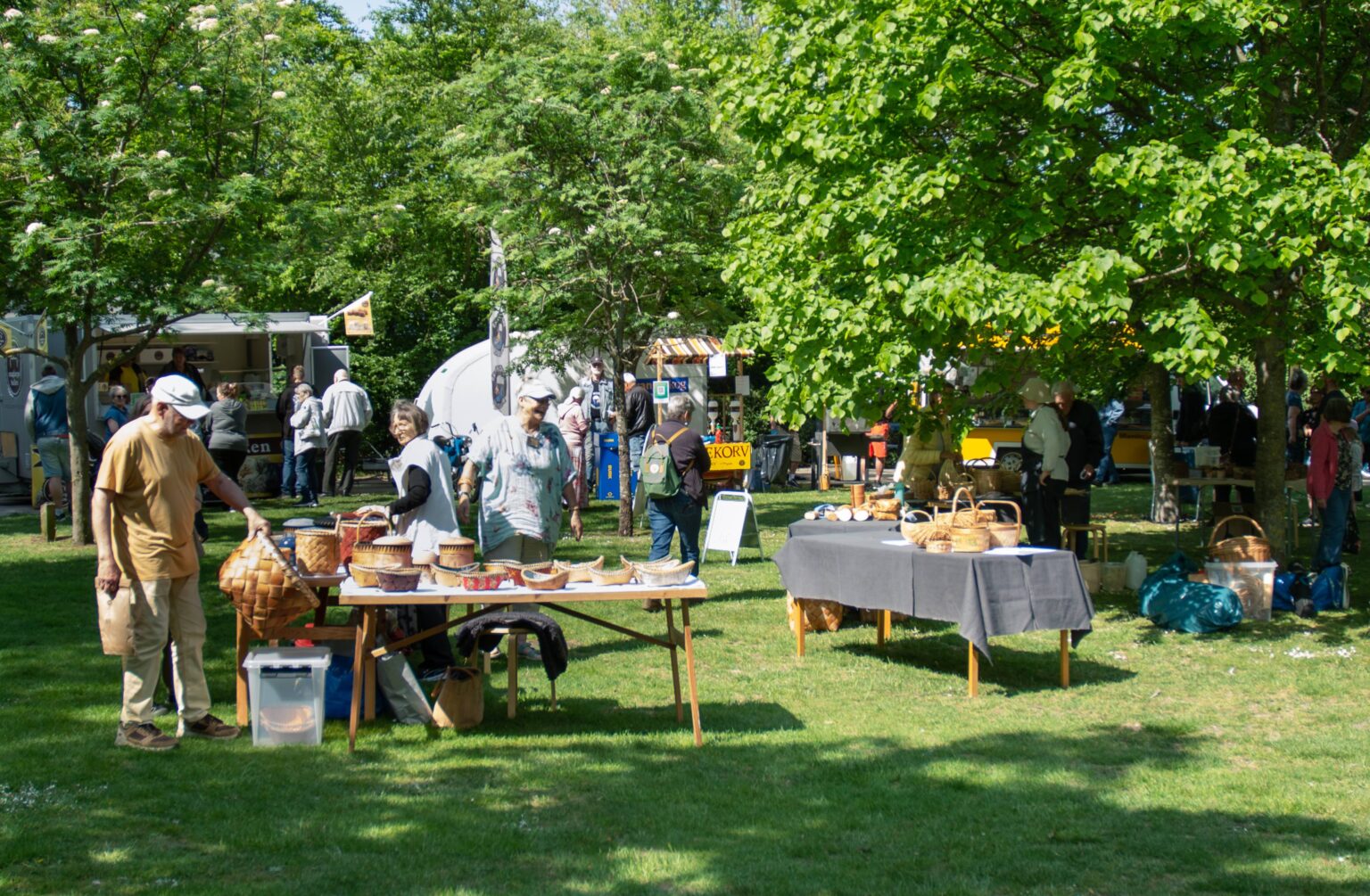
During the project period, many public programs have been carried out. Among other things, a basket festival was arranged in Trelleborg where 20 basket makers participated and a lot of interested visiters. Photo: Sofia Månsson.
Broad collaboration
In collaboration with the National Association of Swedish Handicraft Societies and Sätergläntan – Institute for Crafts, this project conducted two pilot training distance courses corresponding to five weeks of full-time studies. From September 2023, Sätergläntan will be responsible for the course which has been made permanent.

Coiling baskets in rye straw was a part of the first five weeks course. The basket type has mainly been common i Scania (Skåne). Photo: Sofia Månsson.
The project has made targeted investments in basket techniques that are particularly in need of safeguarding, such as the ”Skruck”, a type of goat willow basket that only a few people know how to produce today, and straight-braided chip baskets with hand-split pine chips.
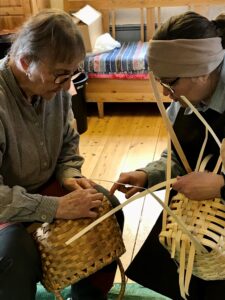
Weaving a Skruck. One starts weaving the top and ends on the bottom. Photo: Helena Åberg.
In collaboration with the National Swedish Handicraft Council, the project issued a call for basket makers. The aim was to analyze the state of knowledge that remains accessible in the country. The appeal was inspired by Pom, the Program for Diversity of Cultivated Plants.
The project has mainly focused on traditional Swedish baskets but some international collaboration has been made. The Danish basket maker Steen Madsen has been involved as a teacher and as a lecturer. There have also been some Danish basket makers in our programs, especially in the south of Sweden. In one of our seminars in Hudiksvall the Norwegian basket maker Hege Iren Aasdal was engaged as a lecturer. Hege has also participated in some activities in the project and shared her experience of splitting wood for baskets.
The project staged an exhibition at the 5th World Wicker and Weaving Festival Poland, where many international contacts with basketry and craft organizations were made.
Activities often take place in collaboration with other institutions, such as authorities, museums, education providers, municipalities, regions and civil society organizations.
Key factors
The project’s key words are breadth and depth, which means that it has been accessible to a variety of people based on their level of interest and knowledge. It involves both information about the history of basketry and its current endangered status as well as direct activities to transfer basket-making knowledge and practical skills from person to person. An important focus has been traditional basketry and how knowledge should be transferred to new generations. Several makers have expressed that they were strengthened by the initiatives taken by the project and that their skills are now being made visible in a larger context.
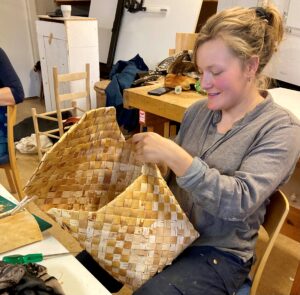
Weaving in birch bark was a part of the second five weeks course. The technique is mostly common in the middle and north of Sweden. Photo:Helena Åberg.
Summing up. Reflections
Working on different platforms both digital and physical has been a success. Furthermore, the project has involved the whole country and has been carried out cooperation with national, regional and municipal entities as well as NGOs and craftspeople.
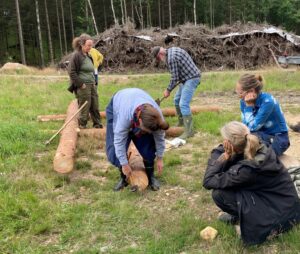
Preparations for the manufacture of a Hedared basket, made of pine shavings, on the first five weeks course. Hedared is a small village in Västergötland where this type of basket were made on a large scale. Photo: Helena Åberg.
Running a project as a collaboration between several regional entities has proven to work very well. A national project provides good geographical spread and impact as well as legitimacy. We have seen increased interest in traditional knowledge and basket making with natural materials, often linked to climate awareness and the need for climate-smart solutions and local production.
Making a targeted investment in project form with earmarked funds creates financial conditions for carrying out our own activities and being able to support external initiatives. The project has created a foundation for a longer course in basketry, something that has been lacking until now and which is certainly a reason for basket manufacturers’ weak position. Additional, longer and more advanced training efforts are needed to strengthen the position of basket making. However, it is positive for the future of basketry that several younger people have participated in the trainings that have been given so far.
Much remains to be done to make basketry’s unique position as one of the world’s oldest crafts more visible. This applies to both the lack of educational opportunities and the makers’ difficulty in achieving financial profitability.
Due to urbanization and changes in forestry, the availability of sufficient material for several techniques is decreasing. This is serious and increases the risk of natural materials being replaced by petroleum products, which poses a threat to the climate and risks the disappearance of important intangible knowledge. In order for basket-making, with all its diversity, to be able to remain with humankind in the future, it is important to collaborate between teachers, craftspeople, educational institutions, cultural heritage institutions, authorities and NGOs. The issues of availability of material and knowledge transfer must be considered.
